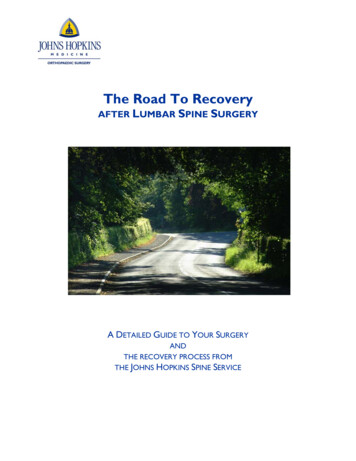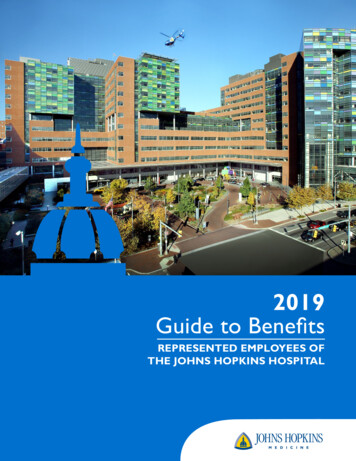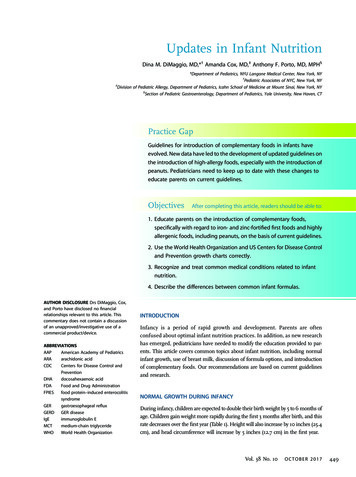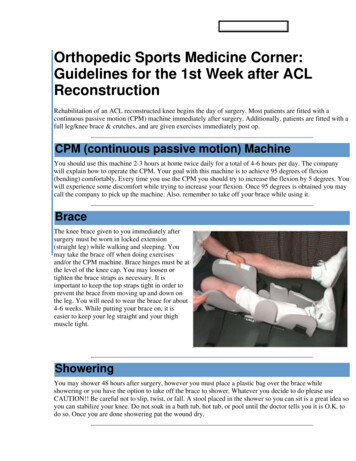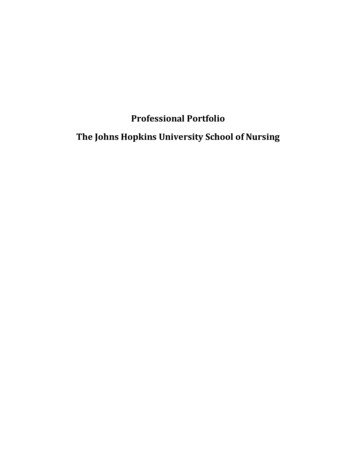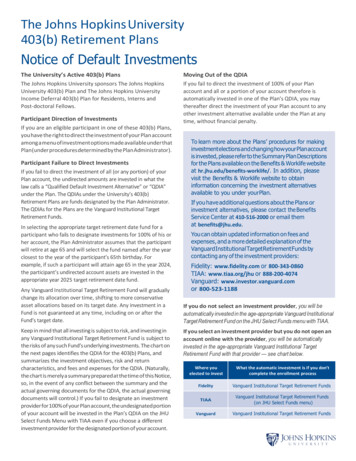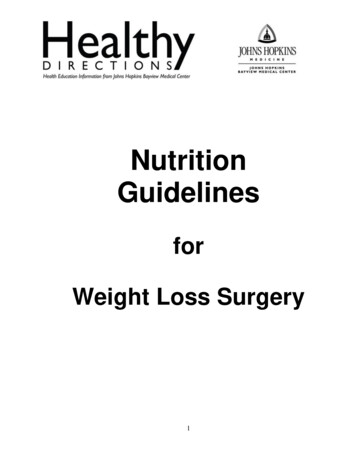
Transcription
NutritionGuidelinesforWeight Loss Surgery1
Why should I follow these recommendations?1. Help to prevent nutritional deficiencies that may result from a decreased intake of food,maldigestion and/or malabsorption of nutrients.2. Help to achieve the maximum amount of weight loss.3. Help to prevent nausea, vomiting, dehydration, hair loss, dumping syndrome and otherpotential side effects.Getting Ready for Surgery It is a good idea to start making changes before surgery to help you prepare for your newlifestyle after surgery.1. Chew your food thoroughly. This becomes very important after surgery. With the reductionin the size of your stomach and other changes in your anatomy you must be able to chew foodto a liquid consistency before swallowing. Not chewing your food enough could result in pain,nausea and vomiting. Start with smaller bites. Cut food into tiny pieces (i.e. pencil eraser-size) and/or use asmall utensil (i.e. child’s fork) to control bite size.Chew each bite approximately 20 times or until liquid.2. Practice eating slowly and stop eating when you feel full or comfortably satisfied. Aftersurgery, it is important to eat slowly in order to recognize your feeling of fullness and preventintolerance. When you feel a pressure in your upper stomach area, this is your new fullfeeling. If you experience pain, you probably took one too many bites, or perhaps ate tooquickly. Sit down and focus on eating. Avoid activities (i.e. reading, watching TV, on computer)where you can become distracted. Practice mindful eating.Savor each bite, noting its aroma, flavor and texture. Engaging all your senses canincrease satisfaction and help prevent over eating.Put your fork down between bites.3. Practice sipping beverages slowly and drink between meals. Drinking too quickly, gulpingand/or drinking too soon after eating solid food may cause pain, discomfort or otherintolerances. When you return home after surgery it may seem difficult to get fluids in initially becauseof inflammation. Aim for 4-8 oz of fluid over an hour. Eventually you should be able to take 8 oz of fluid over 5-15 minutes. Drinking fluids before the meal is OK. Avoid fluids during the meal. Wait 30 minutes after the meal is over before you resume drinking. Straws, especially large straws, may introduce air into your stomach (like gulping) andcause bloating or discomfort.2
4. Drink adequate amounts of fluids to prevent dehydration. Fluid needs are individual andsome people may require more fluid to maintain adequate hydration than others. Your dietitiancan help determine the amount of fluid that is best for you. Aim for at least 64 ounces (oz) per day unless you have been given a higher goal.Increase your fluid intake if you are having signs or symptoms of dehydration:decreased or dark urine, nausea, headache, dizziness, lack of energy, dry skin,dry mouth or a white coating on the tongue.5. Wean off of beverages containing carbonation, caffeine, sugar and alcohol.Carbonation may cause abdominal discomfort and may stretch out your new stomach overtime. Caffeine may irritate the stomach and increase your risk for an ulcer after surgery.Caffeine as well as alcohol may also contribute to dehydration. Beverages containing sugarand alcohol are high in calories and will hinder your weight loss. They may also causeDumping Syndrome after the Gastric Bypass procedure. And last but not least, alcoholmetabolism is altered and you may feel the effects more quickly. Water is a great beverage choice! If you are having trouble tolerating plain water, tryadding a wedge of citrus fruit or sliced cucumbers.Sugar free or light beverages with less than 10 calories per serving are alsoappropriate.Try beverages sweetened with artificial or non-nutritive sweeteners.Try True Lemon/Lime/Orange for touch of flavor without artificial sweetener.Switch to decaffeinated coffee and tea.Avoid ALL beverages with carbonation, even diet soda and sparkling water.If you choose to drink alcohol in moderation after surgery, please do not plan on driving.6. Read food labels. Begin by identifying the amount of sugar, fat and protein in a particularfood. SugarFood and beverages high in sugar will slow down the rate of weight loss and may even causeweight re-gain. For patients having Gastric Bypass surgery, food and beverages that are highin sugar may cause symptoms of flushing, dizziness, weakness, headache, nausea, vomiting,diarrhea and abdominal discomfort known as Dumping Syndrome. Avoid high sugar foods such as sweets, candy, fruit drinks and sodas. Limit foods that contain sugar in the first 3 ingredients on the food label. Aim for no more than 15 grams of sugar per serving. Sugar alcoholsSugar alcohols are sometimes used in foods to provide a sweet taste without the calories ofsugar. You may find sugar alcohol in sugar free foods such as sugar-free candies, cookies, icecream and chewing gum. You may even find sugar alcohol in foods not labeled sugar freesuch as protein bars. If a product contains sugar alcohol the type (i.e. sorbitol, xylitol, mannitol,maltitol, starch hydrolysates, etc.) will be included on the list of ingredients and the amount willbe included on the nutrition facts label. Limit sugar alcohol to less than 10 grams perserving as greater amounts may lead to cramping, abdominal pain, excess gas and/ordiarrhea.3
FatFood and beverages high in fat are high in calories and like sugar will slow down the rate ofweight loss and may even cause weight re-gain. High fat intake may also cause symptoms ofintolerance or Dumping Syndrome. Avoid obviously high fat foods such as fried foods; fast food; snack chips; high fatmeats like bacon, sausage, hot dogs, bologna, pepperoni and wings; cream soupsand sauces like Alfredo; whole milk, ice cream; donuts; cakes; cookies; andpastries. Choose foods that are labeled “light”, “low fat” or “fat free”. When looking at a food label Choose foods with 5% or less of the Daily Value(DV) for total fat. Avoid foods with 20% or more of the Daily Value for total fat.These would be considered a high fat foods. Choose lean cuts of meat. Lean cuts include round, chuck, sirloin and tenderloinand meats that are greater than 90% lean. ProteinProtein is important for wound healing, immune function and maintaining muscle mass. Needsare individual but ranges of 60-80 grams or 80-100 grams per day are often suggested. Yourdietitian can help determine the amount of protein that is best for you. Protein should beconsumed first at each meal, then vegetables and fruits, then whole grains. Eat protein with each meal. Eat protein foods first. Take 2-3 bites of protein followed by a bite of vegetable orfruit and then a bite of starch/whole grains. Avoid dry meats, they are usually not tolerated well.7. Explore, purchase and begin taking protein supplements (see handout). Choose supplements with: At least 20-30 grams of protein per serving. Less than 5 grams of sugar per serving. Less than or equal to 200 calories.Please account for the additional calories of any fluids or foods mixed or blended in (i.e.fruit, yogurt, peanut butter, milk, etc).Choose whey protein isolate over whey protein concentrate and milk proteinconcentrate if you are lactose intolerant or feel symptoms of gas, bloating or are havingloose bowel movements after surgery. Whey protein isolate is absorbed well and has nolactose or milk sugar.Avoid and/or limit products with collagen (not a complete protein).If you mix protein powder with skim or 1% milk you will get an additional 8 grams ofprotein per 8 oz.4
8. Explore, purchase and begin taking vitamin and mineral supplements.Vitamins and minerals are not only important for good health but also for maximum weight lossand long-term weight maintenance. Begin taking a multivitamin (MVI) now if you do not already. Look for a MVI thatcontains 100% Daily Value for iron (18mg), folic acid (400mcg), thiamine (1.5mg) andcopper (2mg). Vitamins and minerals are absorbed differently after surgery therefore dailysupplementation is needed for the rest of your life. See surgery specific handout forrecommendations after surgery.9. Include physical activity in your daily routine. Exercise is recommended as a life-longhabit and is known to improve over-all health, mood and sense of well-being as well asmaximize weight loss. And, a more toned body before surgery can help reduce excess skinafter surgery. The American College of Sports Medicine recommends: 30-60 minutes of moderate aerobic activity at least 5 days a week. One continuoussession or multiple shorter sessions of exercise can achieve the same goal.Strength training 2-3 days a week. Use a variety of exercises and equipment to workeach major muscle group.Before beginning any exercise routine, please consult with your doctor to make sure it issafe for you to exercise.10. Establish support. Social support is associated with increased weight loss after weight losssurgery. Involve family and friends in appointments before and after surgery. They can provideencouragement and help you achieve your goals for a healthier lifestyle. Multiple studies show support group attendance after weight loss surgery is associatedwith greater post-operative weight loss. Johns Hopkins Bayview Medical Centeroffers Virtual Bariatric Support Group twice a month. Support groups are open toboth pre and post-operative patients. When:1st Wednesday of the month from 12-1 pm2nd Thursday of the month from 5-6 pm Sign up:Johns Hopkins Center for Bariatric Surgery website to receive secure Zoom pport-groups.html Remember to see health care providers regularly.5
Before Your Surgery Suggest weight loss before your surgery to improve surgical outcomes. Excess bodyweight and a fatty liver increase surgical risk during upper abdominal laparoscopic surgery.Make healthy food choices and avoid that “last hurrah” before surgery. Two weeks prior tosurgery follow the structured low calorie and low carbohydrate diet below to reduce the size ofyour liver. This will allow your surgeon better access to your stomach and potentially decreasethe risk of complications. (See separate handout on 2 Week Preoperative Diet as well)2 Week Preoperative DietMeal/SnackBreakfastSnackLunchSnackDinnerSnack (optional)Food Choice/Protein ShakeProtein ShakeFruit (serving 1 cup melons or berries OR 1/2 cup of all other fruit)Protein ShakeProtein Shake OR 6 ounces Light Greek yogurt3-6 ounces lean protein AND1 cup cooked non-starchy vegetable OR 2 cups garden salad with2 tablespoons light dressingProtein Shake**In addition to the above meal plan, drink water and other sugar free fluid for a minimum of 64 ounces a day**Within 24 Hours of SurgeryDay before Surgery- Full Liquid Diet (See page 7 for Full Liquid Diet). Clear liquid after midnight.2 hours prior to Surgery- STOP drinking ALL LiquidsFollowing Your Surgery In the Hospital Start Slowly Sipping on Clear Liquids providedFluid Goal before discharge from the hospital- 4 to 8 oz over 2 hoursRemember: Sip and Do Not Gulp. Suggest avoiding straws. Swallowing air may cause abdominaldiscomfort. Drink Slowly. If you feel increasing fullness or pressure under your breast bone, slowdown. You will receive IV fluids to help with hydration while in the hospital but IV fluids will bediscontinued when you are discharged to home.6
After Discharge Home Full Liquid Diet: Post-op Week 1Goals: 60-80 grams of protein per day or more if recommended (at least 2-3 proteinsupplements per day).Aim for 64 ounces (oz) of fluid per day or more if recommended by your provider.o Drink Early and Often! It will probably take an hour to drink 8 oz. Drinking is anALL DAY job. It is nearly impossible to play catch up with your fluids if you do notstart early.o Protein supplements can account for 50% of your fluid goal.Keep logs recording ounces of fluid and grams of protein consumed.Recommended Liquid and Semi-liquids: WaterBrothSugar-free fruit drinksSugar-free popsicles and sugar-free Italian iceDecaffeinated tea and decaffeinated coffeeDiluted fruit juice (maximum of 4 ounces juice per day, diluted with 4 ounces water)1% or skim milkProtein supplementsLow-fat/light or 100 calorie yogurt (plain or flavored yogurt without fruit chunks or seeds,Greek is preferred)Low fat or Fat free cottage cheese (no fruit added)Ricotta cheese made with skim milkSugar-free gelatinSugar-free, low fat puddingSample Full Liquid Meal Plan (Week 1)7:00am8 oz fluid such as decaffeinated coffee8:00am2 tbsp semi-liquid such as fat free plain Greek yogurt8:30am8 oz fluid such as a sugar-free fruit flavored beverage9:00am2 tbsp semi-liquid such as sugar-free pudding10:00 am8-12 oz protein supplement12:00 pm2 tbsp semi-liquid such as sugar-free gelatin1:00pm8 oz fluid such as water with lemon2:00pm8-12 oz protein supplement4:00pm8 oz fluid such as decaffeinated sugar-free iced tea6:00pm2 tbsp fat free cottage cheese8:00pm8-12 oz protein supplement made with 1% or skim milk7
Pureed Diet: Post-op Weeks 2, 3 and 4Goals: 60-80 grams of protein per day or more if recommended (at least 2-3 protein supplementsper day). Eat protein foods first, followed by vegetables, fruits then grains. 64 oz of fluid per day (including protein drinks) sipped between meals. Avoid fluids duringmeals and wait 30 minutes after eating to resume drinking fluids. Foods blended or mashed to liquid/baby food consistency. Avoid spicy foods as well as very hot or very cold foods since they may cause discomfort. Try only 1 new food at a meal so that you know what you can tolerate.FoodProteinChoose2 Tbsp (1oz) provides 6-7 grams of proteinBlendedLean Beef, Pork, Poultry, Fish, Shrimp,Lobster, Crab, Imitation Crab/Lobster, Tunafish in water1 Egg (scrambled), egg substitute2 Tbsp provides 3-4 grams proteinAvoidHigh fat meatsProteins cooked in oil, fatand butterPeanut butter and otherNut buttersCottage and Ricotta Cheese(fat-free, skim milk or 1%)Greek yogurt(fat-free, plain or light without seeds orchunks)Cheese or yogurt madefrom whole milkTofu (soft)Cheese, fat-free or low fat (1 slice or1 oz provides 6-7 grams protein)ProduceTip:Add ProteinPowderMilk, 1% or skim (8 oz provides 8grams of protein)VegetablesSoft, tender varieties, cooked andblended or mashed with a forkFruitsMashed banana, No sugar addedapplesauce, blended canned peaches orpears in 100% juice, blended fresh fruitwithout seeds or skins and baby food fruit8Whole or 2% MilkSalad; Raw;Tough varieties withfibrous stalks,seeds, skins or hulls;Cooked in butter or oilTough varietiesSeeds, skins, hullsFruit in heavy or light syrup
FoodGrains andStarchesTip:Add ProteinPowderSoupsTip:Add ProteinPowderChooseHot cereal (oatmeal, grits, cream of wheat)Mashed white or sweet potatoesBlended/mashed beans(refried beans, hummus)Broth, bouillonBlended- Vegetable soup, Reduced fat creamsoup, Bean soup or Egg drop soupBeveragesWaterDecaffeinated, non-carbonated beverageswith less than 10 calories per 8 oz servingsuch as coffee, tea, Crystal Light , Mio ,Propel Zero , Fruit 2O , Vitamin Water Zero ,True Lemon/Lime/Orange Miscellaneous Light yogurt, sugar-free gelatin, sugar-freepopsicles, sugar-free pudding and custard,sugar- free/low fat ice cream and sherbet,light or low fat mayonnaiseAvoidPasta and noodlesRiceBread and bread productsAll additional starchy foodsnot listed in the choosecategoryGrains prepared with addedbutter or oilRich, high fat cream soupsor soups with chunks ornoodlesAll soda or otherCarbonated drinksCaffeinated coffee/ teaChocolate milkSweetened condensed milk2% or whole milkAll othersInstructions for Pureeing Foods:Buy or borrow a blender or food processor if you do not own one.1. Cut food into small pieces about the size of your thumbnail.2. Place food in the blender.3. Add enough liquid (broth, fat free gravy, fat free yogurt, tomato sauce, etc.) to cover theblades.4. Blend until smooth like applesauce.5. Strain out the lumps, seeds, or pieces of food.6. Use herbs and spices (avoid spicy ones) to flavor food.7. Enjoy!Tip: Use ice cube trays. Each cube holds about 1 ounce. This will help you to control portion sizes and estimate protein. Each cube is about 7 grams of protein if you’re putting pureed lean beef, poultry or porkin the trays. Try preparing your favorite healthy recipe, blend and freeze in the trays.9
Sample Pureed Meal Plan (Weeks 2, 3 and 4)7:00am8 oz fluid such as decaffeinated coffee8:00am8-12 oz protein supplement9:30am8 oz fluid such as water10:30 am2-4 tbsp protein food such as 100 calorie vanilla Greek yogurt11:30 am8 oz fluid such sugar-free fruit flavored beverage12:30 pm2-4 tbsp protein food such as Ricotta cheese (made with skim milk) mixedwith 1-2 tbsp tomato sauce2:00pm8 oz fluid such as sugar-free fruit flavored beverage3:00pm8-12 oz protein supplement4:00pm2 tbsp protein food such as 1% low fat cottage cheese2 tbsp blended or baby food peaches5:00pm8 oz fluid such as water with lemon6:00pm2 tbsp protein food such as blended chicken2 tbsp blended green beans1-2 tbsp mashed potatoes with 1 tbsp fat-free gravy7:30pm8-12 oz protein supplement8:30pm8 oz fluid such as water with lime10
Soft Diet: Post-op Weeks 5, 6, 7and 8Goals: 60-80 grams of protein per day or more if recommended. Decrease protein supplements asprotein foods increase. Eat protein foods first, followed by vegetables, fruits then grains. 64 oz of fluid per day (including protein drinks) sipped between meals. Avoid fluids duringmeals and wait 30 minutes after meals to resume drinking fluids. All foods must be soft or cooked to a soft consistency. Chew all foods well. Try only 1 new food at a sitting so that you know what you can tolerate.FoodProteinChoose1 oz provides 6-7 grams of proteinGround or finely choppedLean Beef, Pork, Poultry,Fish, Shrimp, Lobster, Crab,Imitation Crab/Lobster, Tuna in waterAvoidHigh fat meatsTough, dry meatsProteins cooked in oil, fatand butterLean deli meatsEgg and egg substitute2 Tbsp provides 3-4 grams proteinCottage/Ricotta Cheese(fat-free, skim milk, 1%)Peanut butter and otherNut buttersGreek yogurt (fat-free, plain, light or 100calorie)Tofu (soft)Cheese, fat-free or low fat (1 slice or 1 ozprovides 6-7 grams protein)ProduceMilk, 1% or skim (8 oz provides 8grams of protein)VegetablesTender varieties, cooked until softFruitsMelon, Banana, No Sugar AddedApplesauce, canned peaches and pears in100% juice and other soft fruit withoutseeds, skins or hulls11Cheese or yogurt madefrom whole milkWhole or 2% MilkSalad; Raw; Tough varietieswith fibrous stalksseeds, skins or hulls(peas, corn);Cooked in butter or oilTough varieties,Seeds, skins, hulls andmembranes like freshorangesFruit in heavy or light syrup
FoodChooseGrains andStarchesAvoidHot cereal (oatmeal, grits, cream of wheat)Mashed white or sweet potatoesBeans, hummusToast, crackers without seeds, hard pretzelsRice, pasta and noodles (wait until week 7,8)SoupsBroth, bouillonReduced fat cream soupsEgg drop soupBeveragesMiscellaneousWaterDecaffeinated, non-carbonated beverageswith less than 10 calories per 8 oz servingsuch as coffee, tea, Crystal Light , Mio ,Propel Zero , Fruit 2O , Vitamin WaterZero ,True Lemon/Lime/Orange Light yogurt, sugar-free gelatin, sugar-freepopsicles, sugar-free pudding and custard,sugar- free/low fat ice cream and sherbet,light or low fat mayonnaiseSoft breadBagelsAll additional starchy foodsnot listed in the choosecategoryGrains prepared with addedbutter or oilRich, high fat cream soupsAll soda or otherCarbonated drinksCaffeinated coffee/ teaChocolate milkSweetened condensed milk2% or whole milkAll othersSample Soft Diet Meal Plan (Weeks 5, 6, 7 and 8)7:00am8 oz fluid such as decaffeinated coffee8:00am2 oz protein food such as an omelet (1 scrambled egg with 1 slicelight cheese and 1-2 tbsp cooked vegetables)9:00am8 oz fluid such as water with an orange wedge10:00 am8-12 ounces protein supplement1:001-2 oz protein
See surgery specific handout for recommendations after surgery. 9. Include physical activity in your daily routine. Exercise is recommended as a life-long habit and is known to improve over-all health, mood and sense of well-being as well as maximize weight loss. And, a more toned body before surgery can help reduce excess skin after surgery.
